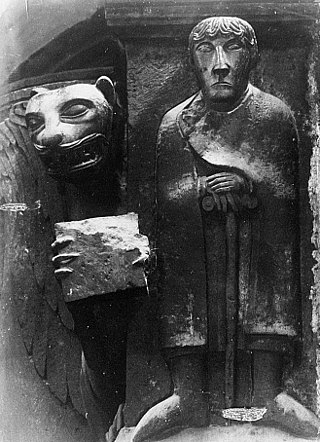Top Qs
Timeline
Chat
Perspective
William of Volpiano
From Wikipedia, the free encyclopedia
Remove ads
Saint William of Volpiano (Italian: Guglielmo da Volpiano; French: Guillaume de Volpiano, also of Dijon, of Saint-Benignus, or of Fécamp; June/July 962 – 1 January 1031) was a Northern Italian monastic reformer, composer, and founding abbot of numerous abbeys in Burgundy, Italy and Normandy.
Remove ads
Life and career
Summarize
Perspective
Not much is known about him. The main source is a Vita of the monk Raoul Glaber, a novice who accompanied William and who sometimes regarded his master as a rival, but also as a mentor who encouraged his work as a chronicler.[1]
William was born on the family citadel on the island of San Giulio, Lake Orta, Novara, Piedmont. The son of Count Robert of Volpiano, he was born during an assault on the citadel by the Emperor Otto. The assault being successful, Otto became the sponsor and patron of Count Robert's son.
The fourth son of Count Robert, in 969, at the age of seven, he began his education at the Benedictine abbey at Locadio, Vercelli. He became a monk at this abbey. In 987, he became a monk at the Abbey of Cluny under Saint Majolus.[2] Zealous for reform, Saint Majolus had reorganized Saint Sernin Abbey on the Rhône River.
William was ordained in 990 and served as abbot of Saint Benignus' Abbey at Dijon, dedicated to Saint Benignus of Dijon. Under William's direction, and his zeal for the Cluniac reform, St. Benignus' became a centre of spirituality, education, and culture.[3] It also became the mother house of some forty other monasteries in Burgundy, Lorraine, Normandy, and northern Italy.
In 1001, he was called to rebuild the destructed Abbey of Fécamp[citation needed] (present-day department of Seine-Maritime) by Richard II,[2] where the Dukes of Normandy had their palace and had chosen to be buried. William had to supervise the (re)construction and to found several abbeys in Normandy (Bernay, and Mont Saint-Michel). In 1015 he became abbot of Jumièges Abbey.[2]
He was chosen as building contractor for Mont Saint-Michel in the 11th century. He designed the Romanesque church of the abbey, daringly placing the transept crossing at the top of the mount. Many underground crypts and chapels had to be built to compensate for this weight. These formed the basis for the supportive upward structure that can be seen today. He also rebuilt the Abbey of Saint-Germain-des-Prés.
William died of natural causes at Fécamp.[citation needed]
Remove ads
Editions
- Mocquereau, André, ed. (1901). Codex H. 159 de la Bibliothèque de l'École de médecine de Montpellier: Antiphonarium tonale missarum, XIe siècle. Paléographie musicale. Vol. 7. Solesmes: Abbaye Saint-Pierre de Solesmes.
- Mocquereau, André, ed. (1905). Codex H. 159 de la Bibliothèque de l'École de médecine de Montpellier: Antiphonarium tonale missarum, XIe siècle. Paléographie musicale. Vol. 8. Solesmes: Abbaye Saint-Pierre de Solesmes.
- Bulst, Neithard; John France; Paul Reynolds, eds. (1989). "Vita domni Willelmi abbatis". Rodulfus Glaber Opera. Oxford Medieval Texts. Oxford: Clarendon Press. pp. 154–299. ISBN 9780198222415.
- Gazeau, Véronique; Monique Goullet (2008). Guillaume de Volpiano. Un Réformateur en son temps (962 - 1031). Caen: Publications du CRAHM. ISBN 978-2-902685-61-5.
Remove ads
See also
- William of Volpiano's fully notated tonary for the use at the Abbey Saint-Bénigne of Dijon
References
Sources
External links
Wikiwand - on
Seamless Wikipedia browsing. On steroids.
Remove ads



